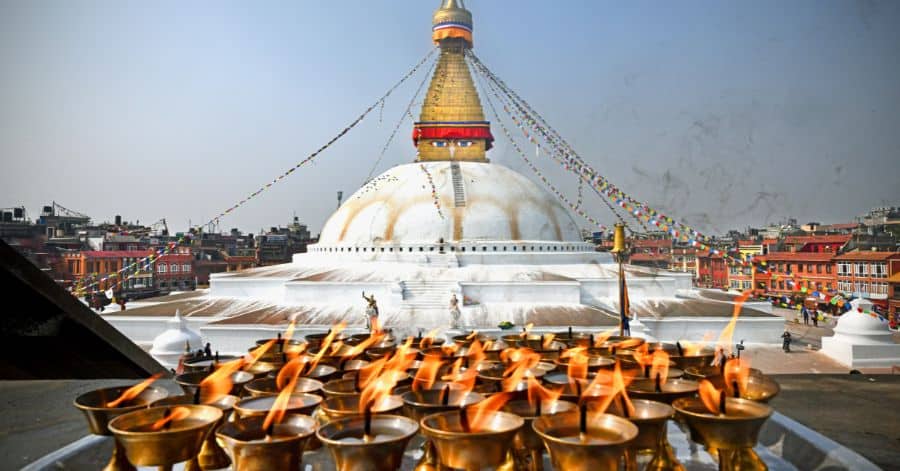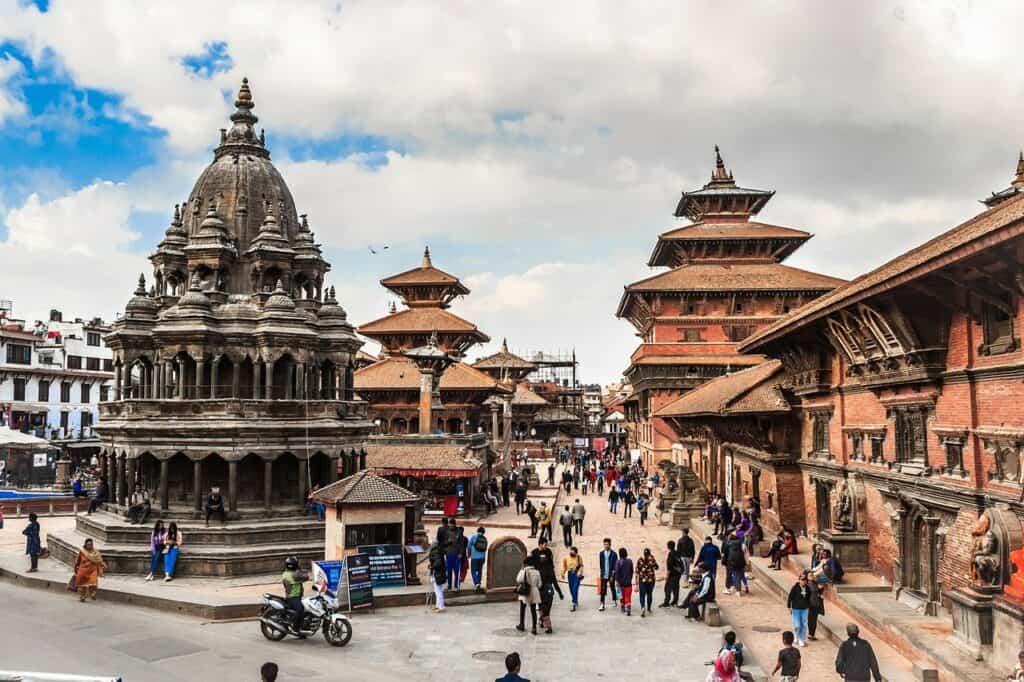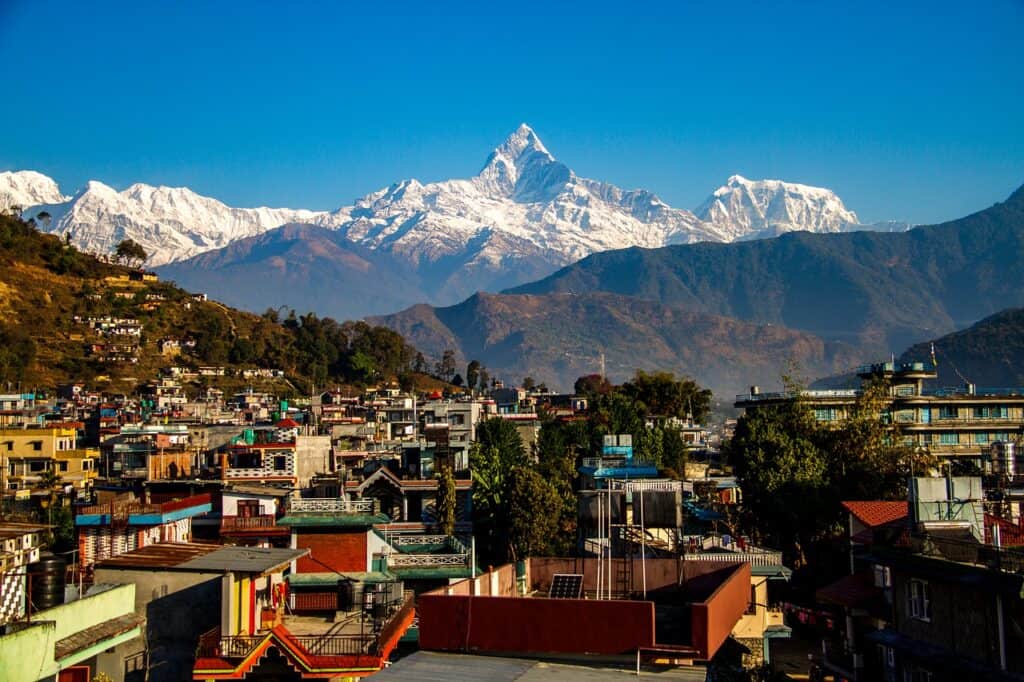Who doesn’t love holidays? A day spent leisurely without worrying about work or school sounds amazing. Regarding holidays, we Nepalis are pretty lucky as we have 35 public holidays annually. And those are excluding 52 Saturdays in a year.
Nepal sees twenty-seven festival holidays, two birth anniversary holidays, and six special national days. Considering these statistics, it’s no wonder that Nepal is the country with the most public holidays. Moreover, if we count public holidays issued for a specific community or religion, the number exceeds 35. It is a blessing and a challenging issue for the nation.
Now, you must look forward to knowing the details of holidays in Nepal. So, we present you this article.
Also Read:
- Best Things To Do In Bhaktapur
- Best Things To Do in Pokhara
- Best Things To Do in Kathmandu
- Best Things To Do In Nagarkot
- Nepalese New Year
- Ram Navami
- May Day
- Buddha Jayanti
- Ubhauli
- Ganatantra Diwas/Republic Day
- Eid al-Adha
- Janai Purnima And Raksha Bandhan
- Gai Jatra
- Krishna Janmashtami
- Indra Jatra
- Sambidhaan Diwas/Constitution Day
- Dashain Holidays
- Tihar Holidays
- Chhath Parwa
- Udhauli
- Christmas Day
- Tamu Lhosar
- Maghe Sankranti
- Sonam Lhosar
- Sahid Diwas/Martyrs' Day
- Democracy Day/Prajatantra Diwas
- International Women's Day
- Maha Shivaratri
- Gyalpo Lhosar
- Holi: Festival Of Colors
- Eid al-Fitr
Nepalese New Year

Many might not know, but Nepalese celebrate the new year with a different calendar. We follow Nepal Sambat, Vikram Samvat, and the Gregorian Calendar.
Among them, citizens widely use and follow Nepal Sambat. The calendar era started in 879 AD and went on. Moreover, the Nepali Calendar is 56 years and eight months ahead of the International calendar. It has twelve months, distinct from January to December.
Usually, Nepalese New Year falls between mid-April from 12-15 on Baisakh 1st. It is a day of celebration and leisure. Nepalese people normally celebrate New Year by visiting relatives, going on vacations, hosting get-togethers and parties, and spending time with their families.
Public places like parks, religious sites, and eateries are full of people at this time of the year. So, booking a ticket first is better if you want to visit any attraction. Furthermore, local markets offer delicious food options, and everyone can enjoy the festivities. People usually enjoy sumptuous feasts during dinner.
Check These Handpicked Activities:
Ram Navami
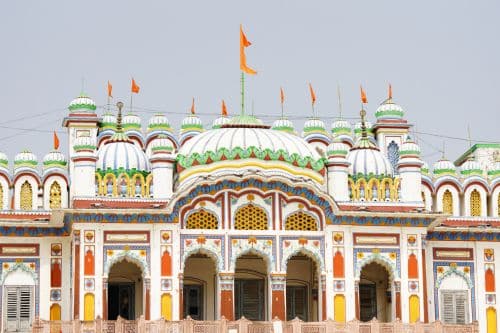
Nepal is a Hindu-dominated nation, with most of the population following the Hindu religion. Ram Navami is a renowned Hindu festival that worships the birth of Lord Rama. The birthday celebration happens on the ninth day of the Shukla Pasha, and this year, it falls on April 17th, 2024.
Historically, Ram is the Hindu deity Bishnu’s seventh avatar. He was the epitome of righteousness and virtue. Lord Rama’s story begins with his birth in Ayodhya as a prince. However, his life was far from that of a privileged prince, as he faced exile from the palace for fourteen years.
Lord Ram and his wife Sita’s story during their exile, Sita’s abduction by Ravana, and the couple’s reunion compose the story of the Hindu epic Ramayana. As Rama was a highly respected Hindu deity, his birth celebration holds a special presence among Hindu followers.
Nepal’s Janakpur district primarily celebrates Ram Navami with grandeur, decorating cities with colorful flowers, lights, and decorative items. They celebrate the festival for nine days; however, the public holiday lasts only a day.
For visitors, Ram Navami will be a perfect occasion to travel to Janakpur. They will experience the district’s spiritual environment, enjoy puja and celebrations, and explore the Ram Navami Mela.
Check This Handpicked Activity:
May Day

May Day is likely not a new name among our readers. European and Western countries like the US celebrate Labor Day on May 1st every year. Likewise, Nepal has declared May 1st a public holiday, dedicating the day to hard-working workers and employees.
Nepali governmental and private institutions allow their employees a day off during the May Day. Nepali labor organizations celebrate the day by organizing peaceful rallies, programs, and meetings. Similarly, political parties host various programs and give speeches.
Everyone celebrates May Day in their way. For instance, some enjoy May 1st by relaxing at home and taking much-needed time away from their hectic office schedules. Some might even celebrate the day by working. Whatever the case, May 1st is a public holiday for all Nepalese.
Check These Handpicked Activities:
Buddha Jayanti

Nepal is the birthplace of Lord Buddha; Buddha’s teachings have a massive influence on Nepalese people. As such, Buddha Jayanti or Buddha Purnima marks the birth of Siddhartha Gautam in Lumbini.
Not just that, the day commemorates Lord Buddha’s enlightenment, teachings, and death. Legend says all those things happened the same day throughout Buddha’s life. It falls on Baisakh or Jestha of the Nepali calendar (March – April).
Nepali Buddhists visit Swayambhunath, Boudhanath, and other monasteries to offer prayers, flowers, and candles in the early morning. They also participate in events and celebrations around these stupas and shrines. Furthermore, schools and religious organizations host peaceful rallies, spreading Buddhist teachings while roaming the streets.
Lumbini sees a grand celebration on the occasion of Buddha Jayanti. It includes a chariot procession of Lord Buddha through the streets. Buddhist devotees join the procession, reciting Buddhist prayers, singing songs, and uttering slogans. Furthermore, there are several competitions and programs organized on this day. Winners also receive prizes at the end of the competition on the same day.
Check These Handpicked Activities:
- Private Lumbini And Kapilvastu Buddhist Pilgrimage Tour
- Full Day Lumbini Tour
- Buddhist Pilgrimage/ Cultural Tour in Nepal
Ubhauli
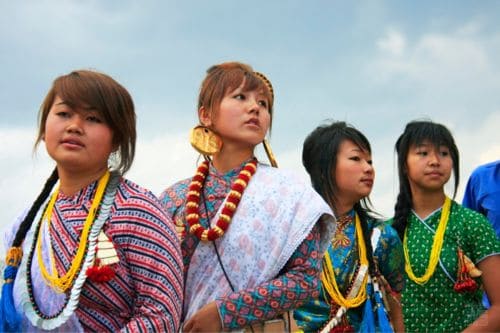
(Source: Wikimedia Commons)
Nepal is a home of multi-ethnicities, multilingual, and multicultural people. Each community has its festivals, languages, cultures, and traditions. Speaking of which, the Kirat community celebrates Ubhauli from the Baishakh Shukla Purnima.
The celebration lasts for a month from the full moon of Baishakh. It falls on the same day as Buddha Jayanti. Rai, Limbu, Sunuwar, and Yakkha castes celebrate this festival with joy and grand festivities.
Ubhauli means upwards, and as its name suggests, this festival celebrates migration towards upper hilly regions during the summer. Historically, the Kiranti people were indigenous tribes who migrated to various regions in Nepal and established settlements.
They initially migrated to hilly regions to escape heat and diseases like malaria. Before the migration, tribes worshipped Mother Nature and their ancestors. The ritual has now become Ubhauli.
The Kirats were farmers and worshipped Mother Nature. Ubhauli is one of their rituals to thank and pray to Mother Nature for protection. They perform Bhumi Puja to pray for healthy crops. Furthermore, the Kirat community performs their dance, Sakela, in Kathmandu Valley for two weeks. You will see Rai, Limbu, Yakkha, and Sunuwar people donning their traditional attires and participating in festivities around the valley.
Ganatantra Diwas/Republic Day
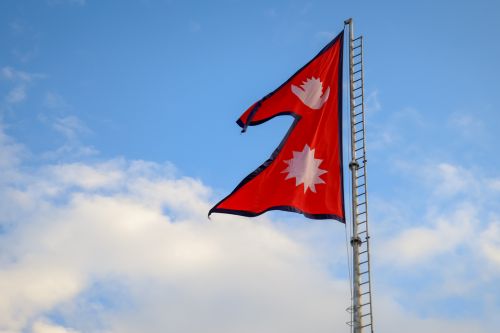
As mentioned before, Nepal has six public holidays issued for special days. Ganatantra Diwas falls on Jestha 15 (May 28 or 29) in the Nepali Calendar. It marks the Constituent Assembly of Nepal’s first meeting on May 28, 2008.
Nepal was under the King’s rule and followed a constitutional monarchy. King held the absolute power and sovereignty in the nation. Nepalese people held several movements throughout the decades to abolish autocratic rule and establish democracy. Their first movement established Prajatantra in 2007 but didn’t bore good results.
Then, Maoists started a revolution in the 1990s that slowly became a full-fledged civil war. People’s revolution eventually overthrew King Gyanendra Shah’s rule and established Nepal as a republic. Finally, on May 28, 2008, the first Nepalese Constituent Assembly came into practice with 601 members.
Nepal’s Republic Day commemorates the Nepalese people’s decade-long revolution and success in overthrowing the Shah Kings’ regiment. People celebrate Ganatantra Diwas by organizing peaceful rallies and programs throughout the country.
Eid al-Adha
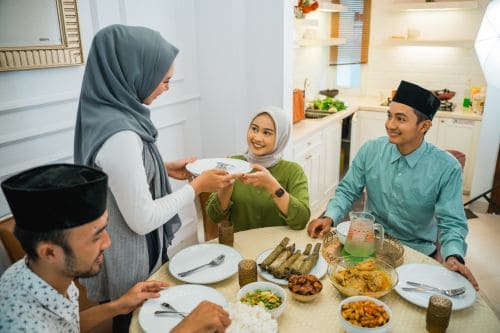
Although Nepal is not an Islamic country, 5.09% of the total population in the country are Muslims. Likewise, nearly 2000 mosques and madrasas are in Kathmandu, Rautahat, Parsa, Bara, and other bordering districts. Nepal has, thereby, issued public holidays for Islamic festivals, including Eid al-Adha.
Also called the Festival of Sacrifice, Eid al-Adha involves the ritual sacrification of animals. It commemorates Ibrahim’s willingness to sacrifice his son, Ishmael. His readiness to slaughter his son depicts Ibrahim’s dedication to the god. Thankfully, God pardoned Ishmael’s life.
Eid al-Adha lasts four days in Nepal, with June 17 a national holiday. Muslims celebrate the festival by offering sacrifices and sharing the meat with their relatives and friends. Out of three parts of the meal, they donate one-third to the needy and poor people.
The people of the Terai region primarily celebrate Eid al-Adha with splendor. They also do charity and donate food, clothes, and money to poor people.
Check Out This Handpicked Activity:
Janai Purnima And Raksha Bandhan
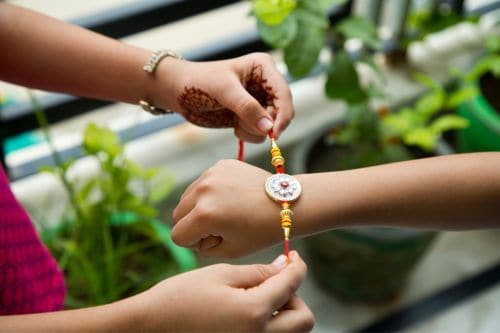
Janai Purnima holds significant importance among the Hindu followers in Nepal. Chhetri and Brahmin men primarily celebrate the festival by changing their Janai, a sacred thread, at the holy riverbanks. Moreover, they receive Janai during their childhoods after performing rituals. Men change their Janai annually on Janai Purnima.
Similarly, Hindu priests tie two threads around people’s wrists today. During Laxmi Pooja in October, they must tie the same thread to a cow’s tail. People enjoy a delicious stew named Kwati, made up of sprouted beans.
Janai Purnima is practiced in August in Nepal’s Kathmandu Valley and Hilly regions. Rasuwa District’s Gosaikunda is full of people during the Janai Purnima. Other crowded sites are Patan’s Kumbeshwar Temple and Dolakha’s Charikot.
On the other hand, Raksha Bandhan also falls on the same day. It involves sisters tying rakhis around their brothers’ wrists. Rakhi symbolizes a sister’s love and affection towards her brother. The latter gives money, clothes, or gifts in return.
Raksha Bandhan signifies the strong bond between a brother and a sister. The tradition is not limited to biological siblings; people sharing a strong connection can also celebrate this ritual. It is primarily practiced in Kathmandu Valley and the Terai region of Nepal.
Check These Handpicked Activities:
- Himalayan Gosaikunda Helicopter Tour from Kathmandu
- Gosaikunda Helicopter Tour
- Amazing Short Gosaikunda Trek from Kathmandu Nepal
Gai Jatra
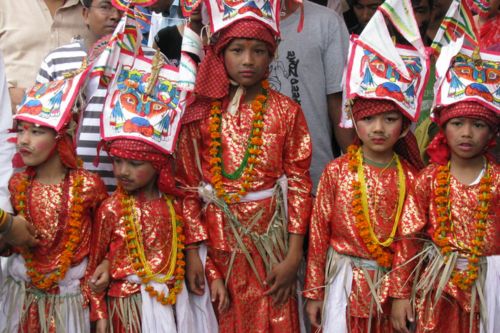
After Janai Purnima and Raksha Bandhan, Gai Jatra is celebrated in Kathmandu, Patan, and Bhaktapur. It usually falls on the day after Janai Purnima in August. What’s more, this celebration will be something you have not seen before.
The celebration’s origin dates back to Kathmandu King Pratap Malla’s reign. After losing their teenage son, King Malla’s queen was not consoled no matter what. Afterward, the King asked the households who had lost their family members in the past year to take out a gai jatra procession.
After watching the procession, the queen realized that other people had also lost their family members, and it was not only her. Finally, she was consoled and could cope with her loss.
The tradition has since been passed down from generation to generation. It celebrates remembering the loved ones who passed away within the past year. The Newar community celebrates Gai Jatra with grandeur, dressing up as cows and deities.
Bhaktapurians celebrate Gai Jatra by taking out chariots with the deceased person’s photo from households. They lead the chariots through the streets of Bhaktapur Durbar Square. Moreover, Newars perform the local Ghintang Ghisi Twak dance by banging two sticks according to beats. It is a very fun and festive celebration.
Check These Handpicked Activities:
Krishna Janmashtami
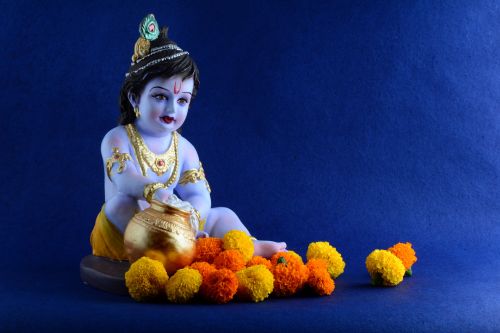
Another Hindu celebration on our list, Krishna Janmashtami, usually falls in September, a week or more days after Gai Jatra. Nepal’s government has issued a public holiday on this occasion; however, some private firms may not follow this rule.
As its name suggests, Krishna Janmashtami commemorates Lord Bishnu’s avatar Lord Krishna’s birthday. Krishna is a highly worshipped Hindu deity whose followers have started separate sub-religions and sects. For instance, Krishna Pranami in Nepal considers Krishna a supreme god and follows a strict vegetarian diet.
People celebrate Krishna Janmashtami by visiting Krishna temples, dancing, singing, and fasting. Little children are dressed as Krishna and participate in plays and dramas based on Lord Krishna’s life. Furthermore, mainstream media usually provides live coverage from several Krishna shrines and broadcasts Krishna’s animations, films, and dramas.
You must visit Patan’s Krishna Mandir to celebrate Krishna Janmashtami in Nepal. It is decorated impressively and crowded at that time of the year.
Check These Handpicked Activities:
Indra Jatra
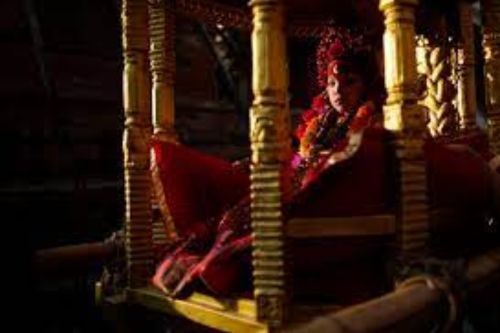
(Source: Wikimedia Commons)
Indra Jatra is a grand celebration in the Kathmandu Valley. Many might know that Nepal has a living goddess called Kumari. She is a prepubescent girl who lives in Kumari Ghar. Kumaris have to pass several tests to receive this honor. For instance, their feet can never touch the ground.
Indra Jatra is an eight-day celebration that falls in September. The Nepal government normally issues a public holiday on the 15th day of Yanla or lunar month. Furthermore, the festival involves Kumari’s chariot procession, dances, Bhairava’s masks exhibition, and several more chariot processions.
The chariot processions happen on Basantapur, Maru, Indra Chowk, Nyata, etc. The festival is a grand celebration and holds massive importance among the Newar community. It also commemorates the memories of the deceased, such as Gai Jatra.
Check Out These Handpicked Activities:
- Catch a sight of Kumari living goddess of Nepal and walk along local Asan Bazzar
- Kathmandu Valley Full Day Tour
Sambidhaan Diwas/Constitution Day

As aforementioned, Nepal’s Republic Day commemorates the Constituent Assembly of Nepal’s first meeting on May 28, 2008. The next Constituent Assembly was elected in 2013. It drafted the Consitution Of Nepal 2072 two years later, in 2015.
Constitution Day, or Sambidhan Diwas, commemorates this historic moment and is celebrated on Ashoj 3rd annually. Nepal has issued a national holiday on Constitution Day. Furthermore, political parties, government officers, and private institutions organize programs nationwide on this auspicious occasion.
The Nepali Army performs a special ceremony on Consitution Day yearly in Tudikhel. Various army units perform cultural performances, conduct military parades, and organize many activities. Likewise, army helicopters with Constitution Day banners fly around Kathmandu, showering flowers.
Dashain Holidays
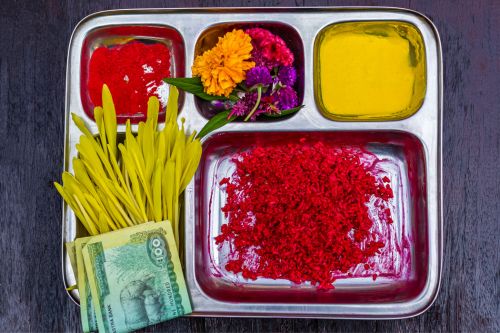
Among Nepal’s 27 festive holidays, Dashain takes 7-8 days. The festival lasts fifteen days and falls in Ashwin or Kartik (September or October). Offices often provide bonuses to their staff to celebrate Dashain.
Dashain is the biggest Hindu religion that worships the goddess Durga. The major occasions are Ghatasthapana, Phulpati, Maha Asthami, Maha Navami, and Bijaya Dashami. The latter involves juniors receiving tika and blessings from elders.
After Bijaya Dashami, Hindus visit relatives’ houses to receive tika until Kojagrat Purnima on the 15th day. Moreover, Dashain involves ritual sacrificing of he-goats, buffaloes, birds, and sheep. For instance, a mass sacrifice happened at Taleju Temple, Hanuman Dhoka, and Rajdevi Temple, Janakpur.
Check These Handpicked Activities:
Tihar Holidays
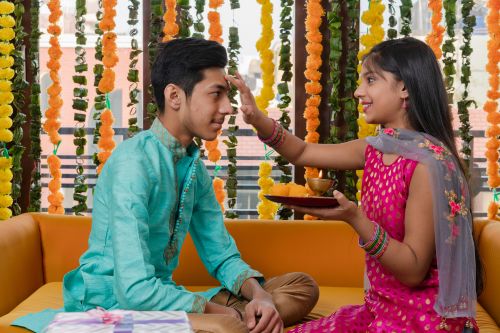
Tihar is the second-largest Hindu festival that lasts for five days. The Nepal government allows three-day public holidays on Laxmi Puja, Govardhan Puja, and Bhai Tika. Each day holds a special meaning and is celebrated with grand festivities.
Tihar is a festival of lights, meaning people decorate their houses with diyos, fairy lights, and LED lights. Nepalese people worship crows, dogs, the wealth goddess Laxmi, cows, and oxen. The fifth day is Bhai Tika, when sisters put seven-colored tika on their brothers’ foreheads. Women give sel roti, candies, and dried fruits, while men give money, clothes, and such.
This festival is a very fun occasion that comes right after Dashain. Nepalese people also go on vacations to enjoy their long holidays. Many city residents return to villages to celebrate Dashain and Tihar with their families.
Chhath Parwa
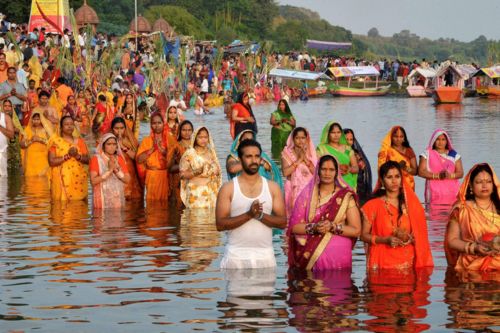
(Source: Wikimedia Commons)
Chhath is another festive holiday that comes six days after Tihar. The four-day-long celebration mainly falls on Kartik (October-November). The Nepal government annually allows one day off on the occasion of Chhath Parva.
The festival is all about worshipping the solar deity, Surya. Devotees thank the sun god for bestowing the life of every creature on the Earth. The celebration is grand in the Terai region, primarily in Janakpur, Birgunj, and Rajbiraj. Kathmandu Valley’s Maithili-Madheshi residents also celebrate this festival.
People make several traditional dishes for Chhath Puja. Their renowned dishes include Thekua, Kaddu Bhaat, Kheer, Green chickpeas, kasar laddu, puri, and rice. They are all super delicious and not easily found in restaurants.
Udhauli
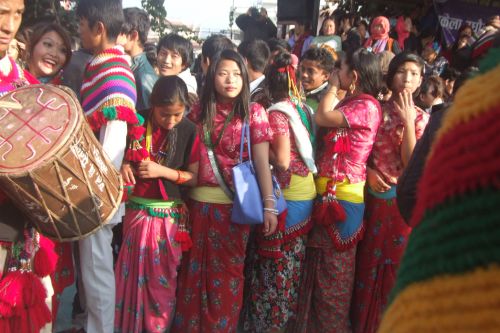
(Source: Wikimedia Commons)
Do you remember we mentioned Udhauli before in our list? Well, Udhauli is the opposite of Ubhauli festival. Celebrated from Mangsir Shukla Purnima, this festival also worships Mother Nature, thanking her for the good harvest.
Udhauli means downwards; this festival marks the Kiranti people’s migration to lower regions to avoid harsh winter in the hilly region. It usually occurs between November and December and in Mangsir in the Nepali calendar.
Another legend says Udhauli is based on the story of the sun god Paruhang falling in love with Sumnima, the goddess of the Earth. Likewise, the Sakela dance is done to find love like that of Paruhang and Sumnima.
The celebration starts with a Rai priest, Nakchhong, doing Chula puja. He then offers a sacrifice at Sakela Thaan and starts dancing to mark the ceremony’s completion. Then, young people perform the Sakela dance on the beats of traditional instruments like Dhol and Jhyamta. The celebration ends with people enjoying delicious dishes.
Christmas Day

Looking at our list, you likely thought Nepal only has holidays for Hindu and Buddhist festive occasions. But that’s not the case, as the Nepal government has declared December 25 a public holiday. However, private institutions hardly allow a day off during Christmas.
Although not as grand as the Dashain and Tihar celebrations, you will undoubtedly feel the Christmas spirit in the air in Kathmandu. For instance, markets will have Christmas gifts, caps, and trees. Many houses and offices showcase Christmas trees and decor. Also, many people attend churches on December 25th to partake in Christmas celebrations.
Christmas is an occasion that brings different communities together regardless of their religious differences. You don’t have to be a Christian to celebrate Christmas in Nepal. This also showcases the harmonious relationship between Nepalese people.
Tamu Lhosar
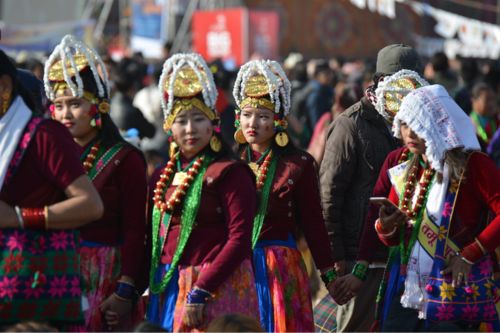
(Source: Flickr)
The Nepal government has issued a holiday on Tamu Lhosar for the Gurung community and those who celebrate it. Here, Tamu means Gurung, while Lhosar refers to the new year. So, Tamu Lhosar is Gurungs’ new year.
The community annually celebrates this festival on Poush 15 (December/January). You will see Gurung people donning their traditional attire, dancing, and enjoying Tudikhel and the streets of Kathmandu Valley. Tamu Lhosar marks the end of the previous year’s suffering and is the beginning of prosperity in the coming days.
Maghe Sankranti
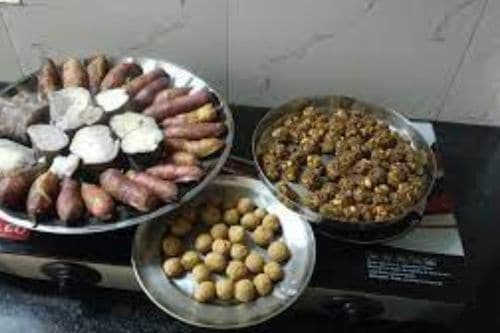
(Source: Wikimedia Commons)
Maghe Sankranti holds a special presence in the Chhetri, Buddhist, Tharu, Newar, and Magar communities. Each ethnic group celebrates this festival in their way. The Nepal government has declared Magh 1st (January 14) a public holiday to celebrate the Maghi festival.
The Magar community celebrates Maghe Sankranti by inviting their married daughters for festivities. They also organize many cultural programs in Tudikhel. Likewise, the Tharu community performs traditional dances like Maghauta, Mahutiya, and Lathi.
On the other hand, Chhetris and Brahmins visit shrines and temples to take ritual baths. Many flock over the Gandaki River, Devghat, Kaligandaki, and Koshi River. They also invite married daughters and in-laws for get-togethers.
Another interesting thing about the Maghi festival is the Nepalese people’s food culture. They consume special dishes like sel roti, yam, chaku, sesame laddos, ghee, and sweet potatoes. They also share the food with neighbors and relatives.
Check These Handpicked Activities:
Sonam Lhosar
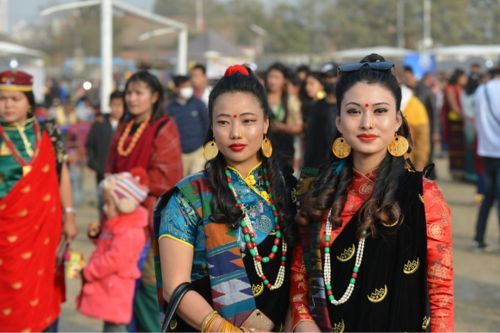
While Tamu Lhosar was the Gurung community’s New Year festival, Sonam Lhosar is that of the Tamang and Hyolmo communities. It falls on Magh Shukla (January – February).
Tamang people celebrate Sonam Lhosar with various activities and festivities. Many visit Buddha stupas, shrines, and monasteries in the early morning. Likewise, many attend the Sonam Lhosar celebration in Tudikhel. They wear traditional attire and jewelry and perform traditional dances such as Tamang Selo.
This festival is also a time for meeting relatives and exchanging greetings. Tamang and Hyolmo people enjoy this day with splendor. They also enjoy a grand feast, consuming beef, chicken, mutton, khapsey, babar, and sweet desserts.
Sahid Diwas/Martyrs’ Day
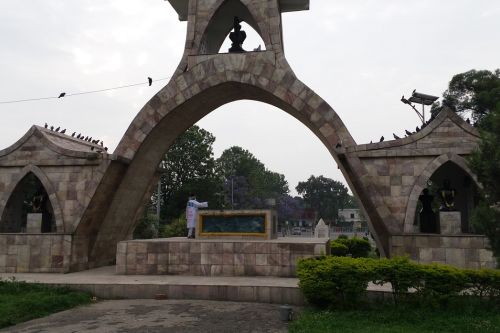
Nepal wasn’t built in a day. Although it was never under any foreign domination, Nepalese people were suppressed under autocratic rule. They fought tooth and nail to make Nepal a federal republic democratic country.
To achieve Nepal’s current glory, many Nepalis sacrificed their lives in the civil war and people’s movements. Nepal annually celebrates Sahid Diwas (Martyrs’ Day) on Magh 16 (January 30) to commemorate the memories of lost martyrs. Magh 16 is a public holiday for government and private institutions.
Kathmandu’s Sahid Gate pays homage to the nation’s first four martyrs, Shukraraj Shastri, Dashrath Chand, Dharma Bhakta Mathema, and Ganga Lal Shrestha. They were executed during the Rana regime. Furthermore, Sahid Diwas is celebrated nationwide by organizing programs, rallies, and events.
Democracy Day/Prajatantra Diwas
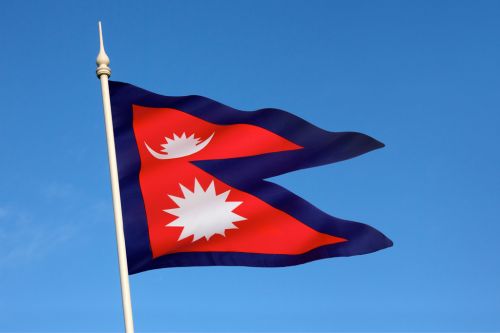
Democracy Day is another national holiday that commemorates the establishment of Democracy for the first time in Nepal. It happened on Falgun 7, 2007 BS (18th February 1951). It was a historic moment when the Nepalese people overthrew 104-year-old Rana’s rule.
To provide some background, Nepal has always been under the King’s rule. Then, the Ranas came into power in 1903 after Jung Bahadur Rana became the prime minister. It started a century of suppression, cruel, and autocratic regimes. Later, people fought to establish democracy and escape from Ranas’ tyranny.
During that period, Shukraraj Shastri, Dharma Bhakta Mathema, Dashrath Chand, and Ganga Lal Shrestha fought to abolish the Rana’s rule. Sadly, they faced execution by shooting and hanging. Eventually, the Nepalese people succeeded in abolishing the Rana regime and established democracy on Falgun 7, 2007 BS.
Although the first democracy wasn’t very successful, it was a milestone in Nepalese history that marked the beginning of prosperity and peace in the nation. Hence, Prajatantra Diwas is celebrated with joy and grandeur.
Check This Handpicked Activity:
International Women’s Day
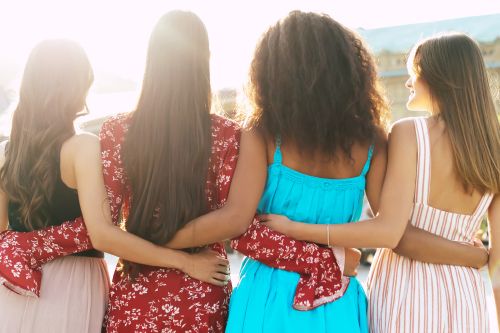
It is no rocket science to know that there is no gender equality in the world. Women are always subjected to gender bias, stereotypes, and discrimination. Nepal is also a patriarchal society, where females are placed under males in their homes, offices, public places, and everywhere.
Nepalese women are always subordinate to their male counterparts. It is a common belief in Nepal that women require a male protector to survive. Slowly, we are seeing a shift in laws and systems, but people’s perspectives are far from changing.
Nepal’s decision to allow a holiday for women on International Women’s Day is perhaps an acknowledgment of their roles in economic, political, and social sectors. Many national and international institutions host programs and campaigns to achieve an equitable society.
The UNDP Nepal is hosting a poem competition in the upcoming International Women’s Day on March 8, 2024. The theme is Invest in Women: Accelerate Progress. Anyone can participate in this campaign with the hashtag #InvestInWomen.
Maha Shivaratri
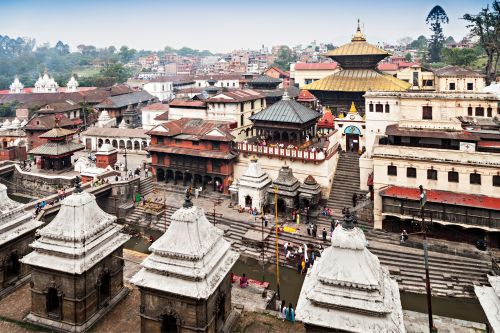
Maha Shivaratri is a famous Hindu festival commemorating Lord Shiva’s wedding to Parvati. It is a grand festival whose celebrations start in the early morning and lasts all night. Furthermore, Nepal’s Shiva temples are full of people in this day. Significantly, the holy shrine Pashupatinath Temple sees devotees from India and worldwide.
Hindus often do fasting in Shivaratri. The unmarried girls keep fast praying for a husband like Mahadev or wishing for a nice groom. Some fast without drinking water, whereas some consume fruits and milk. Adding on, people usually break their fasts the next day.
Shiva devotees stay up all night doing pujas and prayers. Many smoke marijuana and drink Bhang. Furthermore, Nepali Hindus light bonfires to dispel darkness and protect their houses from evil. Finally, the Shivaratri Mela happens from Shivaratri in the Pashupatinath vicinity for a week.
Check Out These Handpicked Activities:
- Pashupatinath Aarati Trip from Kathmandu
- Pashupatinath Temple, Hindu Crematorium and Aarati in-depth Tour
Gyalpo Lhosar
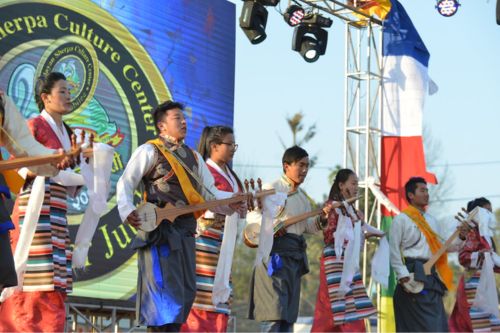
We are adding another New Year celebration to our list. This time, it is the Sherpa community’s New Year festival, Gyalpo Lhosar. The Nepal government allows a holiday for Sherpa people and those who celebrate this festival. It usually falls on Falgun Shukla (February – March).
Unlike Sonam Lhosar and Tamu Lhosar, Gyalpo Lhosar doesn’t finish within a day; it lasts for two weeks or sometimes fifteen days. Sherpa people celebrate the Lhosar by performing traditional dances, decorating houses, getting together with relatives, and enjoying a sumptuous feast.
Lhosars are all about enjoying delicious food; Gyalpo Lhosar is no exception. Its deep-fried pastry Khapse is a must-have snack. Similarly, Sherpas enjoy Gutung, a soup of nine beans with dumplings. They also consume a Tibetan beer, Changkol.
Holi: Festival Of Colors
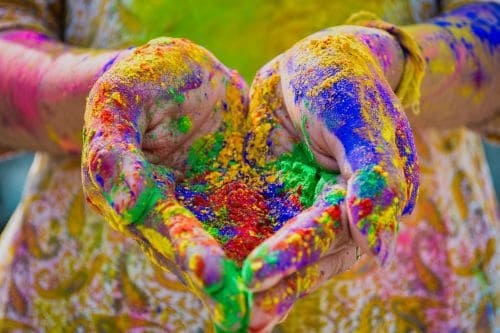
If I had to choose my favorite holiday out of 35 Nepali holidays, I would choose Holi. It is a colorful festival where people put colors on each other’s faces and participate in water activities. The day commemorates the burning of Holika, signifying good’s triumph over evil.
The Nepal government allows a one-day holiday on the occasion of Holi. Kathmandu often celebrates this colorful festival in Falgun or Chaitra. The Terai region celebrates the festival the day after.
Kathmandu residents often gather in groups and visit Basantapur to partake in festivities. During this day, many Holi special programs, concerts, and events are hosted in the valley. Although ticket prices might be a bit high, they will be worth the fun you will have at the event.
Even if you are not a color fan, you will be affected by the vibrant and joyful atmosphere. Ultimately, you will try to put colors on others’ faces and engage in water activities. The only regret is that the festival occurs only once a year.
Check This Handpicked Activity:
Eid al-Fitr
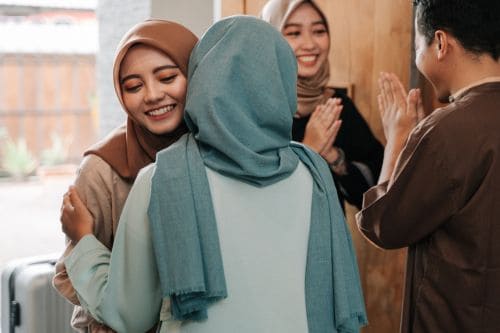
Eid al-Fitr is the second-biggest Islamic festival in Nepal after Eid al-Adha. It marks the end of a month-long fasting called Ramadan. The fasting also includes refraining from sexual activity, alcohol, food, and impure thoughts. It tests Islamic devotees’ faithful intention.
Eid al-Fitr occurs two months before Eid al-Adha and is celebrated for three days. You can’t fast on either Eid celebrations as it is prohibited. Furthermore, Eid al-Fitr starts with a morning prayer in the community.
The Muslims then enjoy meals and conversations with family, relatives, and friends. They collect Zakat al-Fitr (a mandatory charity) beforehand to ensure everyone can participate in the festival. The money is distributed among needy and poor people.
Holidays in Nepal are typically associated with its culture, history, and tradition. Nepal’s festivals and holidays go side by side. Nepali holidays honor Nepalese ethnic groups’ festivals, pay homage to late historical figures and moments, and follow significant international events.
So, does Nepal’s decision to allow 35 public holidays sound reasonable? Or does the country need to reduce its days off? We leave the answers to your judgment.
